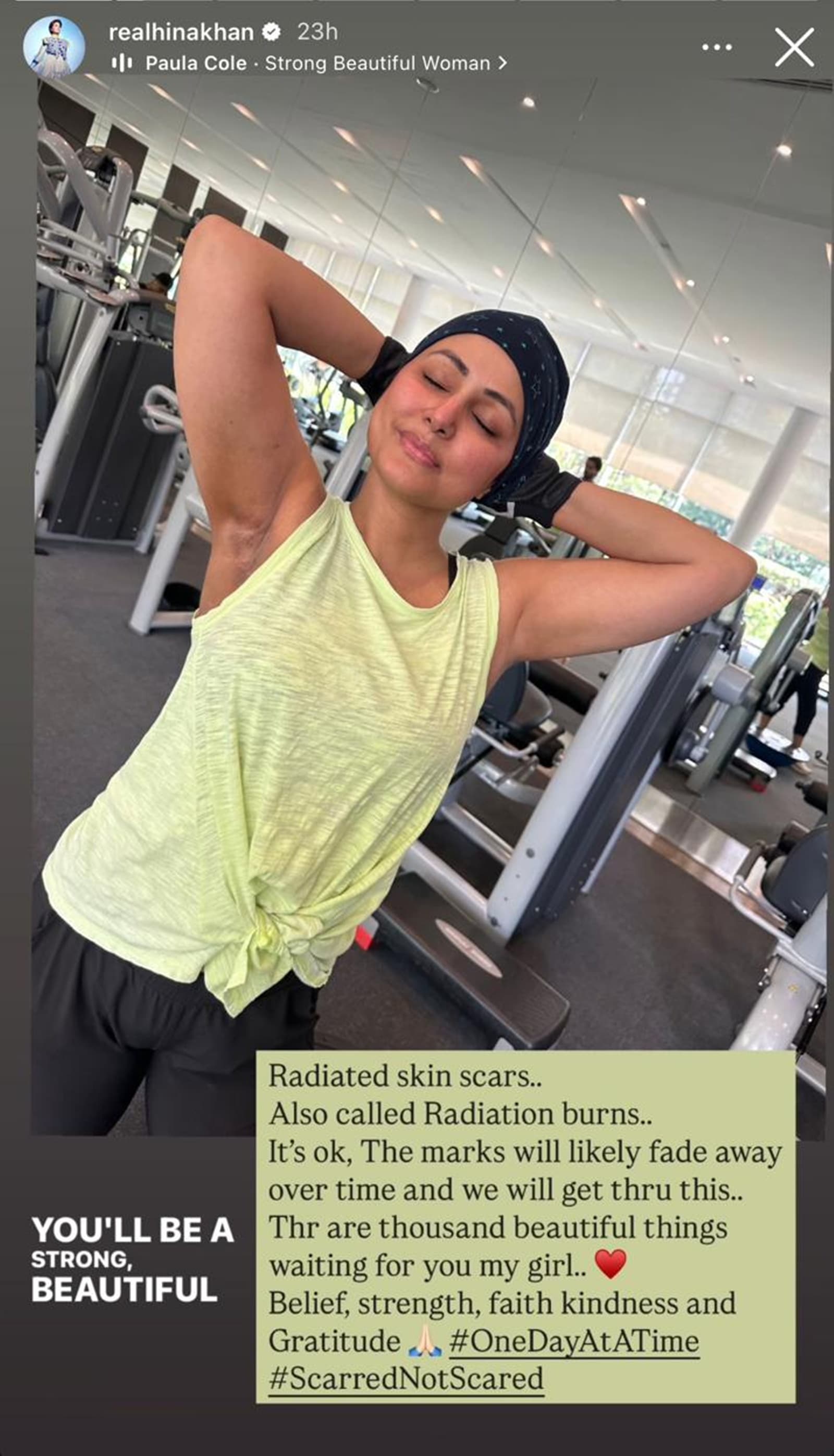📣 For more lifestyle news, click here to join our WhatsApp Channel and also follow us on Instagram
Hina Khan shows radiation burns from cancer treatment, shares a positive note: ‘Scarred not scared’
"There are a thousand beautiful things waiting for you, my girl...," Hina Khan wrote
 Hina Khan shares a health update (Photo: Hina Khan/Instagram Stories)
Hina Khan shares a health update (Photo: Hina Khan/Instagram Stories)Hina Khan, who is currently undergoing immunotherapies after completing chemotherapy sessions, recently showed radiation skin burns in a selfie taken at the gym. Taking to her Instagram Stories, Khan, who has been highly vocal about her breast cancer journey, wrote, “Radiated skin scars. Also called radiation burns. It’s ok. The marks will likely fade away over time and we will get through this. There are a thousand beautiful things waiting for you, my girl…Belief, strength, faith, kindness, and gratitude. #Onedayatatime. #Scarrednotscared”
What causes radiation burns?
Dr Gaurav Jaswal, senior consultant and radiation oncologist at Onco Life Cancer Centre, Talegaon, said radiation burns or radiation-induced skin injury occur when the skin is damaged due to exposure to a high dose of ionising radiation, a form of energy that can change our body. “These can occur from any of the sources, including medical treatments like radiation treatment for cancer, nuclear accidents, industrial radiation exposure, and prolonged sun exposure,” said Dr Jaswal.
These are different from thermal burns, and in clinical practice are called radiation dermatitis. Every year millions of people undergo radiation treatment in India and around the world. According to Dr Jaswal, 90 per cent of these people will develop some form of radiation-induced skin injury or dermatitis, which can range from mild in most cases to severe in a few.
“Symptoms include itchy skin, discoloration, pain, swelling, and ulceration in severe cases. Taking extra precautions to care for your skin during and after radiation therapy can help protect it and aid healing,” said Dr Jaswal.
The severity depends on:
*Dose of radiation (higher doses cause more damage)
*Duration of exposure (longer exposure worsens effects)
*Skin sensitivity (some people react more severely)
Dr Jaswal highlighted that most radiation burns are mild, self-limiting and easily treated. “In fact, many people don’t notice symptoms until a few weeks (or about a quarter of the way) into treatment and some people don’t develop radiation burn until after their final session,” said Dr Jaswal.
 Hina Khan on radiation scars (Photo: Hina Khan/Instagram Stories)
Hina Khan on radiation scars (Photo: Hina Khan/Instagram Stories)
Here’s an expert guide
*Avoid vigorous rubbing or scrubbing over the area
*Gentle washing with lukewarm water and mild soap is only recommended
*Wear loose and soft clothing over the area and avoid direct sunlight over it
*Do not apply any lotions, creams unless recommended by your doctor
*Never use any cold or hot packs on the radiation site
Numerous existing medicaments and dressings are available to prevent and treat, but use them only as per the guidance of your treating physician, said Dr Jaswal.
“The only signs to worry about and warrant immediate medical attention will be high-grade fever, foul-smelling discharge from burn site, and the concerned region being warm to the touch and discoloured,” said Dr Jaswal.
DISCLAIMER: This article is based on information from the public domain and/or the experts we spoke to. Always consult your health practitioner before starting any routine.
📣 For more lifestyle news, click here to join our WhatsApp Channel and also follow us on Instagram
Photos





- 01
- 02
- 03
- 04
- 05





















